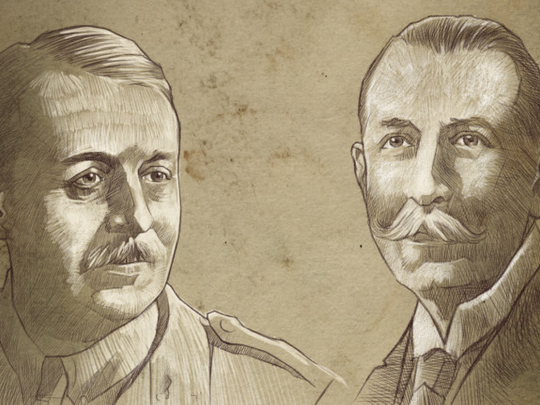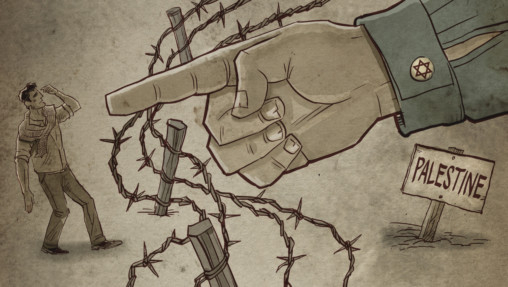
One hundred years ago, this month, in the middle of the First World War, a secret agreement was concluded between two relatively minor British and French officials to carve up the Ottoman Empire — which was allied with Germany — after its presumed defeat.
Mark Sykes was a British MP, while Francis Georges-Picot (a forebear of French president Valery Giscard d’Estaing) was the former consul-general in Beirut. The 1916 Sykes-Picot agreement drew a diagonal line from the Mediterranean coast to the Persian frontier: The northern areas would go to France while those to the south would come under British control. Pre-revolutionary Russia endorsed the plan, which only became public knowledge when the Bolsheviks, having seized power a year later, found copies of the ‘treacherous’ documents and revealed them to the world.
The Arab lands the Ottomans had held since 1516 were strategically important to the British, lying between two key colonies — Egypt and India.
Born of imperialism and colonialism, with total disregard for the wishes of the indigenous population, the Sykes-Picot agreement created divisions (and nation states) that did not exist before and opened the door for the Zionist dream, which was endorsed just one year later in the Balfour declaration.
I was born in a refugee camp in Gaza two years after my parents had been forced to flee Ishdod Ashdod, the village their families had inhabited for generations. They left their olive groves, goats and their house by the sea because the Israelis had arrived armed with guns, threatening the villagers with death if they did not immediately leave.
The ‘state of Israel’ had been declared by the Zionist movement in Palestine only weeks before, but my parents knew these were no idle threats — Deir Yassin cast a long shadow and was only one of more than 30 massacres that armed Zionist gangs committed in this first rush of ethnic cleansing, which saw 750,000 Palestinians displaced.
Where was the rest of the world when the 1948 Nakba (catastrophe) was underway? Where was the newly created United Nations, which had been established to uphold international law and prevent any repetition of the horrors of the Second World War? Where were the British who had been given a mandate to rule over Palestine at the 1920 San Remo conference?
The answers lie in a complicated web of international treachery and deceit that began with the secret 1916 Sykes-Picot agreement. The agreement’s main aim was to incentivise the ongoing bloodbath by dividing up one of the most likely spoils of war: The Ottoman Empire.
As Sykes was dividing up the Middle East between the great powers, another British official — Sir Henry McMahon, the British high commissioner in Cairo — was busy promising it to someone else. Sharif Hussain Bin Ali of Makkah had been assured that, if he provoked and led an Arab uprising against the Ottomans, he would be made emir of a new Arab confederation, comprising much of the Empire’s Arab lands. Significantly, it was implied that this Pan-Arab state would include Palestine. Hussain gathered a militia of a few thousand tribesmen — which the British labelled ‘the Arab Army’, providing a flag for it too — and in June 1916, launched the revolt that would significantly weaken the already failing Ottoman Empire.
In 1917, the British army wrested Palestine from the Ottomans. Now another secret plan for my homeland was revealed, not from minor officials, but from the home secretary himself. In November, Arthur James Balfour issued a declaration to the British Zionist Federation (BZF) that the government supported the establishment of a Jewish homeland in Palestine, the BZF having assured Balfour, months earlier, that the Zionists in America could influence the Woodrow Wilson administration to join the war — a decisive factor in the allied victory.
Three significant, contradictory and opposing projects for Palestine now existed: None made any mention of, or consulted, the Palestinians themselves. The 1920 San Remo conference saw the Middle East carved up under British and French mandates, more or less along the arbitrary lines of Sykes-Picot, with no reference to existing geopolitical circumstances, tribal, ethnic or religious groupings or the wishes of the region’s inhabitants.
As for Hussain, despite his ambitions being betrayed, he ensured allied interests would be maintained locally — one son, Faisal, accepting the throne of British-mandated Syria and Iraq, while another, Abdullah, became King of Jordan.
Jewish migration to Palestine was now permitted by the British with numbers initially limited in order to prevent a full-scale Arab revolt. Zionist terrorism, which had been ongoing since the 1930s, escalated after the Second World War.
The British decided to pull out of Palestine, washing their hands of the mess they had helped create. In November 1947, the UN partitioned Palestine into two states, one for Arabs and one for Jews. As the final British troops left on May 14, 1948, the Zionist movement in Palestine declared the establishment of the state of Israel.
And this brings us back to the beginning of my story, for within days, the Zionist terror groups repackaged themselves as the army of the fledgling state and turned their guns on the Palestinians whose homes and lands they now sought to occupy.
As Israel grew in strength and gradually expanded its illegal borders through colonies and war, the Arab world sought unity to challenge the Zionist state and reclaim the Palestinians’ legitimate rights.
Unsuccessful wars against Israel by the Arab armies in 1948, 1967 and 1973, galvanised the drive towards Pan-Arabism, which marched alongside the Palestinian resistance. The decline of the Palestinian resistance and the current Palestinian National Authority’s pliability have seen even the compromise position of a Palestinian state evaporate since there is no longer any land to house it.
The legacy of Sykes-Picot has been a century of discord and war, but the West has not finished with us yet. United States Secretary of State John Kerry recently presented a ‘Plan B’ for Syria — a project that is already in place, de facto, in Iraq and looks likely in Libya and Yemen, if not the whole region — the federal model, with mini states for Kurds, Shiites and Sunnis. Is this divide and rule round two?
Abdel Bari Atwan is the editor-in-chief of digital newspaper Rai Al Youm. He is the author of The Secret History of Al Qaeda; A Country of Words, his memoirs; and Al Qaeda: The Next Generation.










